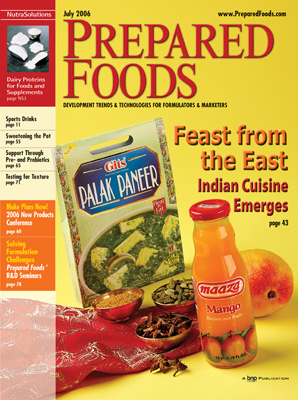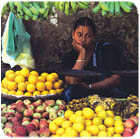
In the Limelight
Michael Batterberry is one of the world's most highly respected experts on dining. Chairman of the food advisory committee for the Smithsonian's Folklife Festival, he is on the board of the French Culinary Institute and the Rockefeller Stone Barns Center for Food and Agriculture. Additionally, he is in The James Beard Foundation's Who's Who of Food and Beverage in America and founded both Food & Wine and Food Arts magazines with his wife, Ariane. During the recent Research Chefs Association national conference in Houston, Batterberry was asked to moderate a key session on coming flavor trends. As part of his opening remarks he said, “Fine Indian cuisine may not be available in every small town in the U.S. today, but it soon will be.”The annual Worlds of Flavor Conference held in Napa Valley, Calif., sponsored by the Culinary Institute of America, often showcases flavors, ingredients and culinary techniques that will become the next hit items on America's restaurant menus. A big part of the 2005 event was the wonderfully beautiful and amazingly flavorful recipes being demonstrated by one of the world's highest-rated TV food stars. Surprisingly, it was chef Sanjeev Kapoor from India. A third of a billion viewers worldwide watch chef Kapoor create exciting, delicious traditional recipes every week. However, he was not the only expert in Indian cuisine speaking at last year's conference.
Chef Hemant Mathur, owner of Dévi, one of the hottest restaurants in Manhattan, also demonstrated some of his best selling recipes. Chef Abhijit Saha, executive chef for the Park Hotel in Bangalore, and chef Suvir Saran of New York, were among the most popular speakers. Each shared the same message: “Indian cuisine is hot!” (and they were not talking about spicy).
Indian cuisine is poised to become a significant cuisine in America. We have seen numerous articles telling us so, and those same articles mention the same familiar dishes and spices. They tell us how culturally diverse India is and how many languages are spoken.
The time is right for Indian cuisine in the U.S., but what factors set the stage for this “perfect storm” of flavors? The trail was blazed first by Cajun/Creole cooking and then Mexican/Latino cuisine. The intense flavors and exotic aromas of East Indian foods might have been too extreme for most of our grandparents. Today, we are a nation ready for new tastes. Americans are far more accepting of wild, exotic flavors and ingredients. Three groundbreaking chefs may have made this possible.

PHOTO COURTESY OF THE NATIONAL RESTAURANT ASSOCIATION
The Groundbreakers
In the early 1980s, chef Paul Prudhome, of the famous Commander's Palace Restaurant in New Orleans, made Americans enthusiastic about Creole cuisine. While the spicy, sometimes intense flavors of New Orleans were exotic and exciting, they also were familiar enough to be accepted by the mainstream consumer. Chef Prudhome clearly was a trendsetter and a culinary genius. His fabulous recipes and techniques (remember blackened redfish?) opened our eyes to new culinary experiences, and prepared us for what was to be the next enduring culinary shift.In the mid-1990s, chef Rick Bayless' Frontera Grill in Chicago became a prominent restaurant. The menu items served at his establishment were very different from the tacos and burritos Americans had believed were typical Mexican food. Bayless offered amazing upscale hauté cuisine mexicano. The never-ending flow of new immigrants from across the southern border ensured a growing demand for Latino products and ingredients. These newly available foods and spices quickly found their way into the hands and onto the menus of chefs all across the country. Latin fusion cuisine became popular in every major city, and it continues to gain popularity. Spicy no longer is a scary word to most knowledgeable diners.
Today's consumers are ready and eager for the next flavor hit, and chef Maneet Chauhan shook up the Chicago restaurant scene in 2004 with a new style of cuisine. Along with her partner and co-owner Rohini Dey (both originally from India), the two blend Indian and Latin American cooking. The groundbreaking restaurant, Vermillion, combines the similar ingredients (spices, rice, chilies and vegetables) of two very different cultures into a wonderful symphony of flavors and aromas. Chef Chauhan quickly became a national media darling, and she addressed the nation's top food professionals as part of this year's National Restaurant Show in Chicago.
It should be no surprise that an exotic, ethnic cuisine would succeed in New York. Chef Suvir Saran's new cookbook, based on foods featured in Manhattan's Dévi Restaurant, already is a bestseller. That the culinary glitterati in Chicago or New York would flock to the latest trendy spot is expected. However, when the editor-in-chief of Food Arts magazine starts quietly recommending a tiny, ethnic restaurant in a non-descript Texas suburb, we may be seeing a true national trend in the making.
Indika Restaurant is hidden away in a tiny suburb of Houston. Yet, on any given evening, there are reporters from the world's top food magazines, celebrity chefs, gourmet food reviewers and Texas oil barons searching the neighborhood for this hidden gem. Chef and owner Anita Jaisinghani has taken the wonderful recipes and flavors of her childhood in India and brought them to life in Texas. Chef Jaisinghani says, “When I opened Indika, I had one simple objective, to represent Indian cuisine [my cuisine] to the best of my ability. It is not intended to be fusion. I have tried to introduce as much Indian street food--which I believe is the best food in India--as possible. Chaat [an Indian word meaning snack] is now a common word around here. We only serve the food I grew up with. My family is from Sindh [in Pakistan]. However, we do travel back to India twice a year to study food and learn all we can. Of course, it would be an injustice not to incorporate the culinary techniques that we have seen and learned in this country. My food is not fusion. It is, however, Indian cuisine lifted to a new level.”

PHOTO COURTESY OF GITS' FOOD PRODUCTS
A Coming Trend
By recognizing and understanding a coming trend, and taking advantage of it, manufacturers will better meet the future needs of customers. Clearly, this spicy aromatic style of food has a following in urban centers. It has taken root and succeeded in a few unlikely small towns. But will it go mainstream? Consumers' tastes and purchasing patterns are evolving. Indian cuisine is becoming more acceptable and more appealing to an ever-widening section of the American population.However, there is risk involved in being first. New culinary trends are difficult to predict. Consumers are fickle even at the best of times. When consumers buy a TV dinner, their choice is generally one they consider “safe.” The frozen TV dinner is not a trip to the latest trendy hot spot. America's freezers are filled with staples, foods customers buy again and again. And today, in a supermarket freezer case near you, you might find Indian cuisine, or Indian TV dinners!
More than one small manufacturer is now creating frozen dinners based on Indian recipes. When the number one manufacturer of natural and organic dinners starts introducing Indian entrées, we can be sure the fad is becoming a true trend. Amy's Organics is the leader in organic and natural frozen dinner sales. Additionally, it is a nationwide distributor and the nation's leading natural frozen food brand. This rapidly growing niche manufacturer has introduced three new frozen dinner flavors from India. These delicious Indian meals are designed to appeal to those who appreciate fine Indian food:
* Indian Vegetable Korma: Tender organic vegetables in a curry sauce with a rich, mild flavor that comes from coconut milk and organic raisins, cashews and slivered almonds, combined with organic tomatoes and authentic hand-roasted Indian spices. On the side are fragrant golden basmati rice and a dal consisting of a mixture of six delicately spiced lentils and beans.
* Indian Mattar Tofu: A non-dairy variation of the traditional mattar paneer, using tofu along with organic peas in a light, delicately seasoned sauce. On the side are fragrant basmati rice and what they call “Swarn's Golden Lentil Dal,” which is simmered with organic tomatoes, onions and hand-roasted spices.
* Indian Samosa Wraps: (10oz, suggested retail price: $3.79) Two delicious Indian-style wraps filled with a blend of lightly spiced organic potatoes, peas and tofu. A satisfying hand-held meal.
The greatest rewards, in terms of sales and profits, go to those who first recognize a new opportunity, and take advantage of it. Those research chefs and product developers who recognize that India's ancient and complex history of cooking offers a never-ending source of flavors, aromas and colors will be the trendsetters. Food formulators who offer them to their customers now will be gaining the chef's edge. pf

PHOTO COURTESY OF INDIKA RESTAURANT
Sidebar: Key Indian Flavors and Spices
Asafetida powder: Dry powdered ingredient made from a native Indian plant. Used to add a savory flavor note to recipes, its taste is similar to a blend of onion and garlic.Cardamom: An aromatic spice used in both savory and sweet applications.
Chaat: The word used to describe a wide range of Indian snacks and street foods.
Coriander: An aromatic spice made from the seeds of the cilantro plant.
Curry leaves: Small leaves of the kari plant. Used both fresh and dried to add a distinctive flavor.
Dal: Any variety of Indian legumes used in numerous recipes. Dal is also used as the name of some recipes when lentils, beans or peas have been used as the primary ingredient.
Garam masala: A very popular spice mixture used widely in northern India. Cardamom, cinnamon, coriander and black pepper commonly are used in this blend; many variations exist.
Ghee: A shelf-stable type of clarified butter that is very flavorful; used primarily as a cooking oil.
Nigella seeds: Very small black seeds used widely in southern Indian recipes. This ingredient provides a nutty, onion-like flavor note.
Rasam power: Very spicy/hot blend of spices generally used to flavor southern Indian soups (rasams).
Tamarind: A very sour and tart fruit used to bring a counter point flavor note to many Indian recipes.